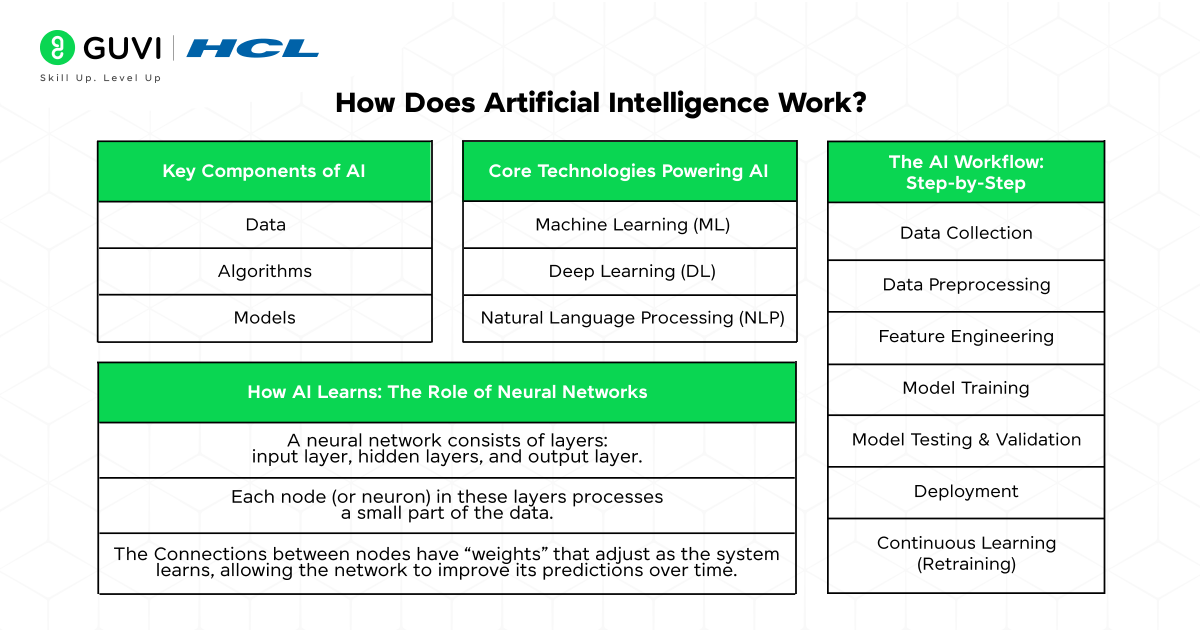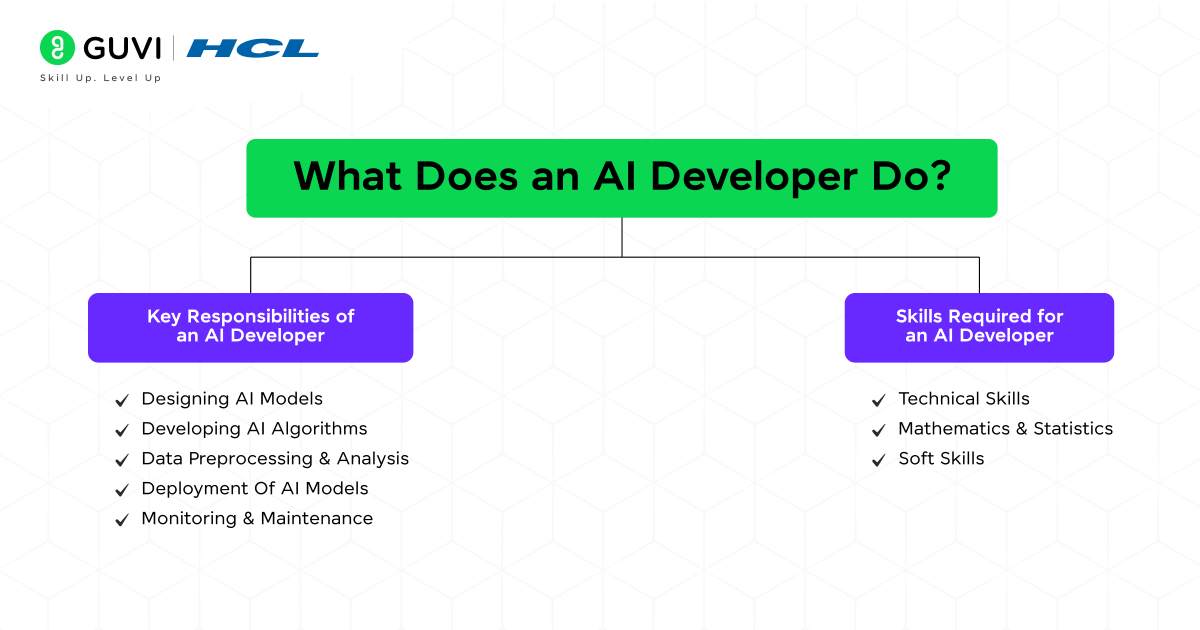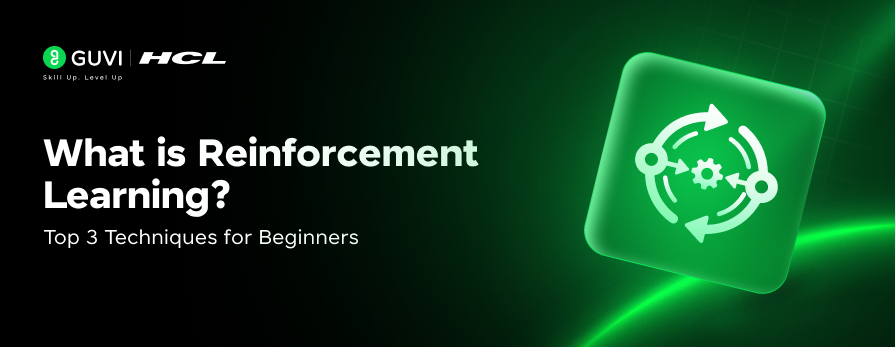
What is Artificial Intelligence (AI)? A Comprehensive Guide
Mar 04, 2025 6 Min Read 4394 Views
(Last Updated)
Artificial Intelligence, or AI as it’s commonly called, is one of those terms you’ve probably heard a million times, especially in recent times, whether it’s in tech discussions, sci-fi movies, or even casual conversations.
As you may have noticed already, AI is ruling the world by having its grip on every tech-related field. Everyone is using it in order to increase their workflow and developers are no exception!
But what exactly is AI, and why is it such a big deal? That is what you are going to learn about in this article! An in-depth look at Artificial Intelligence and why this will change the future of technology!
Table of contents
- The Basics: What is AI?
- Types of AI
- Narrow AI (Weak AI)
- General AI (Strong AI)
- Generative AI
- Superintelligent AI
- How Does Artificial Intelligence Work?
- Key Components of AI
- The AI Workflow: Step-by-Step
- Core Technologies Powering AI
- How AI Learns: The Role of Neural Networks
- Where Do You See AI in Action?
- What Does an AI Developer Do?
- Key Responsibilities of an AI Developer
- Skills Required for an AI Developer
- Career Opportunities for AI Developers
- Salary Ranges for AI Developers in India
- How to Start a Career as an AI Developer
- Should You Be Worried About AI?
- Conclusion
- FAQs
- What is Artificial Intelligence (AI)?
- What are the different types of AI?
- What are the career opportunities in AI?
- What is the average salary for AI professionals in India?
- What are the challenges associated with AI?
The Basics: What is AI?

At its core, Artificial Intelligence refers to machines or systems designed to mimic human intelligence. It’s like teaching computers to think, learn, and solve problems, similar to how you do, but often much faster. AI enables machines to perform tasks that typically require human intelligence, such as:
- Learning from data (like recognizing patterns in a dataset)
- Making decisions (like recommending products on your favorite shopping site)
- Understanding language (like Siri or Alexa answering your questions)
- Even visual perception (like identifying faces in photos).
Types of AI

AI isn’t just one thing, it comes in different forms based on how it’s used and what it can do. Here’s a quick breakdown:
1. Narrow AI (Weak AI)
Narrow AI is the most common type of AI in use today. It’s designed to perform a single, specific task efficiently. For example, it can recognize faces, recommend a movie, or translate languages but it cannot perform tasks outside its pre-programmed function.
Examples:
- Voice Assistants like Siri, Alexa, or Google Assistant
- Spam Filters in your email
- Recommendation Engines like Netflix and Spotify
2. General AI (Strong AI)
General AI refers to machines that possess the ability to perform any intellectual task a human can do. This means it would not only complete a variety of tasks but also think, reason, and learn across different domains.
While it’s a theoretical concept today, researchers aim to develop systems that match human cognitive abilities.
Key Features:
- Adaptable to multiple tasks
- Learns and improves from experiences (like humans)
- Capable of independent decision-making
3. Generative AI
Generative AI refers to a class of artificial intelligence systems designed to create new content, such as text, images, audio, or even videos, based on the data they are trained on.
Applications of Generative AI
- Text Generation:
- Tools like ChatGPT generate conversational responses, write articles, or create code snippets.
- Image Creation:
- Models like DALL-E can create custom images based on textual descriptions.
- Music and Audio:
- AI can compose original music or synthesize realistic voices.
- Video Generation:
- Used in deepfake technology or creating synthetic video content for entertainment.
- Healthcare:
- Generative AI models assist in drug discovery by simulating molecular structures.
4. Superintelligent AI
Superintelligent AI is a hypothetical concept where machines surpass human intelligence in virtually every field from creativity to problem-solving to emotional intelligence. This type of AI is often depicted in science fiction.
Key Features:
- Exponentially smarter than humans
- Capable of self-learning and decision-making without human input
- Potentially uncontrollable due to its immense power
Each type of Artificial Intelligence serves different purposes and has varying levels of complexity.
How Does Artificial Intelligence Work?

To understand how Artificial Intelligence (AI) works, you need to dive into its core processes and technologies. AI is essentially about making machines mimic human intelligence by learning, reasoning, and problem-solving.
But how do machines accomplish this? Let’s break it down step by step.
Key Components of AI
AI is built on several foundational elements. These components work together to enable machines to perform intelligent tasks. Here’s a closer look:
- Data
- Data is the lifeblood of AI. Machines need data to learn and make decisions, much like humans need experiences. The more data an AI system has, the better it can recognize patterns and improve its accuracy.
- Types of data AI uses:
- Structured Data: Organized and easily searchable, like spreadsheets or databases.
- Unstructured Data: Raw and unorganized, like images, videos, or social media posts.
- Algorithms
- Algorithms are the step-by-step instructions or rules AI systems use to process data. Think of them as recipes that guide the system on how to analyze data and make predictions.
- Different algorithms are designed for specific tasks, such as classification, clustering, or regression.
- Models
- An AI model is the output generated after an algorithm is trained on data. It’s what the machine uses to make predictions or decisions in real-world scenarios. For example, a trained model could recognize faces in photos or predict the weather.
The AI Workflow: Step-by-Step
Here’s how AI typically works:
- Data Collection
- First, AI systems need data to learn from. This data can come from various sources, such as sensors, databases, or the internet.
- Data Preprocessing
- The raw data is often messy and unstructured. It needs to be cleaned and organized before being fed into the AI system.
- Feature Engineering
- In this step, the system identifies the most important attributes or features from the data that will help it learn.
- Model Training
- This is where the AI system learns. The system uses machine learning algorithms to analyze the training data and build a model.
- Model Testing and Validation
- Once trained, the model is tested on a separate dataset to evaluate its performance. The goal is to ensure the model makes accurate predictions on unseen data.
- Deployment
- After validation, the trained model is deployed into the real world, where it starts making predictions or decisions based on live data.
- Continuous Learning (Retraining)
- AI systems are not static, they continuously learn and improve over time. New data is fed into the system to retrain the model, ensuring it stays relevant and accurate.
Core Technologies Powering AI
AI doesn’t work in isolation. It relies on several technologies to perform specific tasks. Let’s explore these:
1. Machine Learning (ML)
- ML is a subset of Artificial Intelligence where machines learn from data without being explicitly programmed. Instead of following fixed rules, the system identifies patterns in the data and uses them to make decisions.
2. Deep Learning (DL)
- Deep Learning is an advanced form of ML that uses neural networks, which are inspired by the human brain. These networks consist of layers of interconnected nodes that process data in a hierarchical way.
3. Natural Language Processing (NLP)
- NLP enables machines to understand, interpret, and respond to human language. It powers tools like chatbots, virtual assistants, and language translation apps.
- Examples:
- Google Translate
- Sentiment analysis in customer feedback
How AI Learns: The Role of Neural Networks
Neural networks are at the heart of AI, especially Deep Learning. Here’s how they work:
- A neural network consists of layers: input layer, hidden layers, and output layer.
- Each node (or neuron) in these layers processes a small part of the data.
- The connections between nodes have “weights” that adjust as the system learns, allowing the network to improve its predictions over time.
For example:
- Input: An image of a dog.
- Hidden Layers: The network analyzes the image’s features (e.g., edges, textures).
- Output: The system predicts, “This is a dog.”
Where Do You See AI in Action?
AI is no longer a futuristic concept, it’s all around us, powering tools and technologies that we use daily. Let’s dive deeper into some real-world examples of where AI is actively making a difference:
- Personal Assistants – Alexa, Google Assistant, Siri, Cortana
- Streaming Platforms – Netflix, Spotify, YouTube
- E-commerce – Amazon, eBay, Shopify
- Healthcare – IBM Watson Health, AI-driven diagnostic tools
- Self-Driving Cars – Tesla’s Autopilot, Waymo, Cruise
- Smart Devices – Smart thermostats (Nest), smart security cameras (Ring), smart lights (Philips Hue)
What Does an AI Developer Do?

An AI Developer is a professional responsible for designing, building, and deploying Artificial Intelligence-based systems and applications.
They work with algorithms, data, and technologies to create systems that can solve problems, automate processes, and make predictions. It’s a dynamic role that combines software engineering, data science, and machine learning expertise.
Key Responsibilities of an AI Developer
- Designing AI Models
- Building and training machine learning models to solve specific problems.
- Using frameworks like TensorFlow, PyTorch, or Scikit-learn.
- Developing AI Algorithms
- Writing algorithms for natural language processing (NLP), computer vision, or recommendation systems.
- Optimizing algorithms for performance and scalability.
- Data Preprocessing and Analysis
- Cleaning and organizing raw data for training models.
- Identifying patterns, trends, and insights using tools like Python or R.
- Deployment of AI Models
- Integrating trained models into real-world applications or systems.
- Using cloud platforms like AWS, Google Cloud, or Azure for deployment.
- Monitoring and Maintenance
- Monitoring model performance in production environments.
- Updating models with new data to ensure accuracy over time.
Skills Required for an AI Developer
- Technical Skills
- Programming Languages: Proficiency in Python, R, or Java.
- Machine Learning Frameworks: Experience with TensorFlow, Keras, PyTorch, or Scikit-learn.
- Data Manipulation: Knowledge of libraries like Pandas and NumPy.
- Big Data Tools: Familiarity with Hadoop, Spark, or Kafka.
- Cloud Platforms: Experience with AWS, Google Cloud, or Azure.
- Mathematics and Statistics
- Strong foundation in linear algebra, calculus, probability, and statistics.
- Soft Skills
- Communication and teamwork to collaborate with cross-functional teams.
- Adaptability to keep up with the rapidly evolving AI field.
Career Opportunities for AI Developers
AI development is one of the fastest-growing career fields in the tech industry. Here are some popular roles for AI developers:
1. Machine Learning Engineer: Focuses on building and deploying ML models. Works on tasks like fraud detection, recommendation systems, or predictive analytics.
2. AI Research Scientist: Conducts research to develop new AI algorithms and technologies. Often involves publishing academic papers and collaborating on cutting-edge projects.
3. NLP Engineer: Focuses on natural language processing to enable machines to understand and process human language. Examples include chatbots, voice assistants, or translation tools.
Salary Ranges for AI Developers in India
The salary of an AI developer in India depends on factors like experience, role, location, and the company. Here’s an overview:
1. Entry-Level AI Developer (0–2 years) – ₹4,00,000 – ₹8,00,000 per year
2. Mid-Level AI Developer (2–5 years) – ₹8,00,000 – ₹20,00,000 per year
3. Senior AI Developer (5+ years) – ₹20,00,000 – ₹50,00,000+ per year
4. AI Leadership Roles (10+ years) – ₹50,00,000 – ₹1,00,00,000+ per year
How to Start a Career as an AI Developer
- Educational Background
- A degree in Computer Science, Data Science, Mathematics, or a related field is usually required.
- Build Strong Fundamentals
- Learn programming (especially Python), statistics, and machine learning concepts.
- Hands-On Practice
- Work on real-world AI projects through internships, freelance work, or online competitions like Kaggle.
If you’re passionate about technology, data, and problem-solving, AI development is a highly rewarding career path with immense opportunities for growth.
Should You Be Worried About AI?
For the most part, no, but it depends on how AI is developed and used. Here’s why you shouldn’t worry too much:
- Current AI is Narrow: Today’s AI systems are specialized for specific tasks and are far from being self-aware or threatening.
- Ongoing Ethical Research: Governments, organizations, and researchers are working on guidelines to ensure responsible AI use.
- Job Creation: While AI automates some roles, it also creates opportunities in AI development, data analysis, and related fields.
However, it’s essential to stay informed about the challenges, advocate for ethical AI practices, and focus on leveraging AI for societal benefits. Responsible development and regulation are key to ensuring AI remains a tool for progress.
In case you want to explore more about Artificial Intelligence and Machine Learning, consider enrolling for GUVI’s Artificial Intelligence and Machine Learning course that teaches you everything related to it with an industry-grade certificate.
Conclusion
In conclusion, Artificial Intelligence is a transformative technology that spans various types, from Narrow AI to emerging Generative AI, and has applications in fields like healthcare, e-commerce, and entertainment.
While it brings efficiency, personalization, and innovation, challenges such as bias, privacy concerns, and ethical dilemmas must be addressed. Careers in AI, including roles like AI developers, offer immense growth opportunities, especially in a rapidly evolving world.
As we embrace AI’s potential, responsible development, and ethical use are crucial to ensuring it benefits society as a whole.
FAQs
AI involves creating computer systems capable of tasks that typically require human intelligence, such as learning, reasoning, and problem-solving.
AI is categorized into Narrow AI (designed for specific tasks), General AI (with human-like cognitive abilities), and Superintelligent AI (surpassing human intelligence).
Career paths include Machine Learning Engineer, Data Scientist, AI Research Scientist, NLP Engineer, and Robotics Engineer, among others.
Entry-level AI professionals in India can earn between ₹6,00,000 to ₹10,00,000 per year, with experienced individuals earning significantly more, depending on the role and experience.
Challenges include ethical concerns, potential job displacement, data privacy issues, and the need for substantial computational resources.


















![How to Restore Old Photos with Deep Latent Space Translation: A Beginner’s Guide [2025] 9 deep latent space translation](https://www.guvi.in/blog/wp-content/uploads/2025/07/How-to-Restore-Old-Photos-with-Deep-Latent-Space-Translation.png)
![What is the Minerva Deep Learning Model? An Exclusive Beginner’s Guide [2025] 10 minerva](https://www.guvi.in/blog/wp-content/uploads/2025/07/A-Beginners-Guide-to-Data-Visualization-with-Matplotlib.png)



![What is Object Detection? A Beginner’s Guide [2025] 14 object detection](https://www.guvi.in/blog/wp-content/uploads/2025/07/What-is-Object-Detection_-A-Beginners-Guide.png)

Did you enjoy this article?